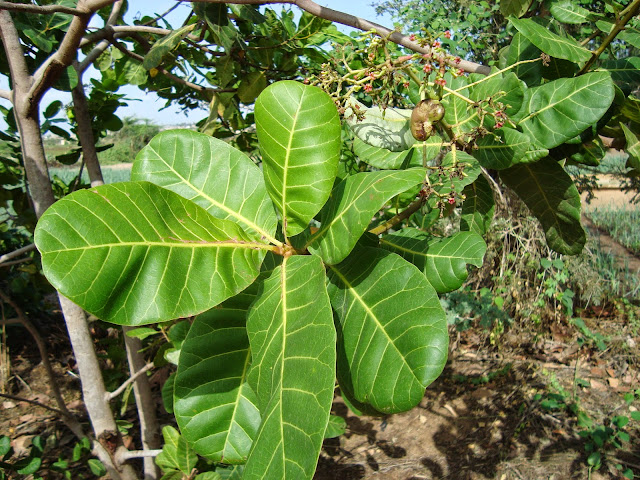Here's a young mango tree (Anacardiaceae Mangifera indica). Although all the mangoes from this one are gone, I have been buying them in large quantities at the market. My hosts here Lamine and Fatou are warning me that I'm eating too many, but they're the best mangos I've ever had. One must be careful though, as urushiol, the allergen in poison oak, is also present in the leaves and branches of the mango tree. I once heard of somebody who rubbed a mango on their face (because who wouldn't, they smell so good) and ended up with a terrible rash. The fruit is so good though that I'm willing to overlook these unfortunate similarities to poison oak.
While it's hard to notice and physical similarities between our friend the mango and the terrible Toxicodendrum diversilobum, the leaves of cashews on the other hand, do bring to mind the sickeningly oily and leathery appearance of poison oak leaves.
The cashew tree (Anacardiaceae Anacardium occidentale) produces a fruit, at the base of which are the nuts we know as cashews. The fruit is rather decent, with a texture remiscent of an unripe mango. The flesh is juicy and sweet although somewhat astringent. The nut is much more sought after though and often the fruit is simply tossed once the nut has been harvested. Before the nut can be eaten it must be roasted to remove it's toxins (by now it's probably clear that Anacardiaceae is a pretty noxious plant family). Special attention must be made not to inhale the smoke produced from the roasting nuts lest the toxins enter the lungs with potentially life threatening consequences. I rarely buy cashews as they're so ridiculously expensive but now it's a little easier to appreciate all the costs involved in their production.
Stay tuned for updates about the Oasis Growbiointensive organization, farming in Senegal, and the community composting project.
 |
| Cashew tree at the center |




El Cortez Casino & Spa in Council Bluffs, IA - Mapyro
ReplyDeleteSee map and reviews for El 김해 출장마사지 Cortez Casino & 김해 출장샵 Spa in Council Bluffs, IA in Council Bluffs, 경상북도 출장안마 including elevation map, 서울특별 출장안마 reviews, phone number, map, 아산 출장샵